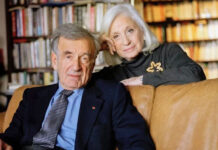Of about 5.3 million Irish citizens, some 800 (.015%) are Jewish. Including Jewish expats in Ireland, that number rises to about 2,500. But however one runs the numbers, Jewish life in Ireland is disappearing.
In another sign of the times, Dublin Hebrew Congregation—which traces its origins to 1936—has put its building in the Terenure neighborhood up for sale. Dedicated in 1953, the synagogue at 32a Rathfarnham Road was designed by Irish architect Wilfred Cantwell, who gave it an iconic façade, with five Star of David windows over squared panels. The listing is for €7.5 million ($8.1 million).
“It was a decision not taken lightly, but made in the respect of a membership base that has declined heavily over the last several years, and not showing any signs of recovering,” wrote a representative of the congregation, who did not provide a name, via email.
The community hopes selling the building will help finance a new synagogue that will serve Irish Jews for decades to come, the representative wrote.
“Irish Jews have made a uniquely disproportionate contribution to world Jewry in other diasporas including Israel,” he said. “Its legacy lives on, even if the traditional Irish community is in terminal decline.”
Emerald Isle Jews have indeed made their mark on the world. Former Israeli President Chaim Herzog—father of President Isaac Herzog—spoke with an Irish accent. And the Jewish Irish Republican Army smuggler Robert Briscoe went on to advise Menachem Begin and befriend Ze’ev Jabotinsky.
Not much is known about Ireland’s first verified Jews in the year 1079. By the 16th century, Sephardic Jews arrived in Ireland after fleeing Spain and Portugal and built the first known synagogue in the country, as well as Jewish cemeteries. That synagogue no longer exists, but Dublin’s Ballybough Cemetery is a remnant of that Sephardic legacy.
The largest wave of Jewish immigrants to Ireland were Ashkenazim, particularly Lithuanians, who arrived in the 1800s. They were the forerunners of the modern Irish Jewish community. At its height, Dublin had nearly a dozen synagogues. There was a synagogue in Limerick, but it closed in 1953. Cork had two Jewish houses of worship, but has been synagogue-less since 2016.
Dublin’s Machzikei Hadass synagogue shuttered last year due to declining membership. Many of its members joined Dublin Hebrew Congregation. The Irish Jewish Museum in the city occupies a former synagogue on Walworth Road.
Just three congregations remain in Ireland today. Beyond Dublin Hebrew, there is the Dublin Jewish Progressive Community and an Orthodox congregation in Belfast.
The soon-to-be-sold synagogue in Terenure was proposed in the 1930s, as Jews began moving out of Dublin and into the suburbs. A group convened to find a way to have Shabbat services in the suburbs, and so what would become Dublin Hebrew was born. The congregation met in rented rooms and in a makeshift structure until its building was completed in 1953.
An arsonist targeted the building in 1966, and several important items, including Torah scrolls, were lost in the fire. The building was severely damaged. The congregation, however, did not miss a single communal Shabbat service. It returned to the makeshift structure until the restoration was completed in 1968. That timing—soon after the Six-Day War—was marked in the synagogue’s stained glass windows, which feature the Temple in Jerusalem. (Fun fact: the intoxicated arsonist fainted due to the fumes; a congregant risked his own life to go inside and save the arsonist.)
Between 1999 and 2004, the Terenure Hebrew Congregation and Adelaide Road Synagogue gradually merged. The combined congregation took on the name Dublin Hebrew Congregation.
Maerton Davis grew up attending the Terenure synagogue. “Many of us have fond memories and will miss it,” he told JNS. “I hope that whoever purchases it respects the building and its significance to our history.”
Stuart Rosenblatt, an Irish-Jewish genealogist, told JNS that Ireland’s Jewish community is aging, and young people moved abroad to “better themselves.” After studying, they found work, married and are raising families elsewhere. Some of the older people in the Irish Jewish community followed their children and grandchildren abroad, and they too made new lives for themselves elsewhere.
“This means fewer people in Ireland to keep Jewish life going—keep the synagogues full, Jewish schools running and a constant supply of kosher food options,” he said.
Ireland will always have a Jewish presence, as it has had for at least 1,000 years, according to Rosenblatt.
“Like the Sephardim and the community before that, the Jewish presence will morph or change into something new. We can see that in Cork for example, with Israelis and other Jewish newcomers building something new,” he said. “However, whenever a member leaves, a major national component of enterprise will be lost, as they take their skills and expertise to another country.”
Looking forward, there may be a bright light for Dublin Jewish life. Zalman Lent, a Chabad rabbi, told JNS that a Chabad center will open in the city in the beginning of March.


























